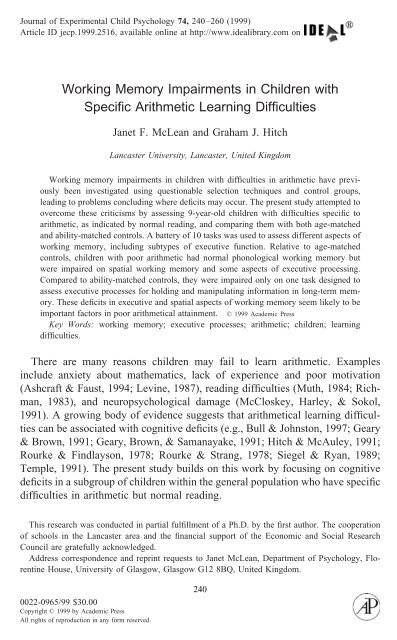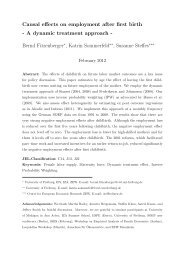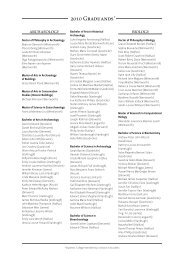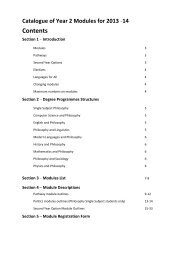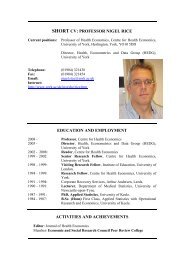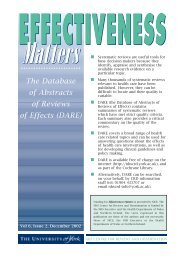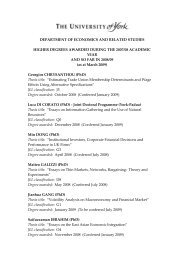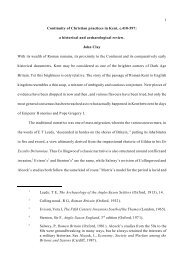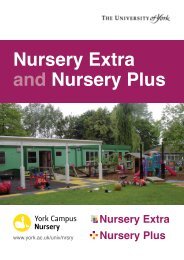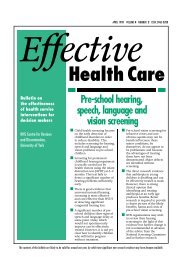Working Memory Impairments in Children with ... - University of York
Working Memory Impairments in Children with ... - University of York
Working Memory Impairments in Children with ... - University of York
Create successful ePaper yourself
Turn your PDF publications into a flip-book with our unique Google optimized e-Paper software.
Journal <strong>of</strong> Experimental Child Psychology 74, 240–260 (1999)Article ID jecp.1999.2516, available onl<strong>in</strong>e at http://www.idealibrary.com on<strong>Work<strong>in</strong>g</strong> <strong>Memory</strong> <strong>Impairments</strong> <strong>in</strong> <strong>Children</strong> <strong>with</strong>Specific Arithmetic Learn<strong>in</strong>g DifficultiesJanet F. McLean and Graham J. HitchLancaster <strong>University</strong>, Lancaster, United K<strong>in</strong>gdom<strong>Work<strong>in</strong>g</strong> memory impairments <strong>in</strong> children <strong>with</strong> difficulties <strong>in</strong> arithmetic have previouslybeen <strong>in</strong>vestigated us<strong>in</strong>g questionable selection techniques and control groups,lead<strong>in</strong>g to problems conclud<strong>in</strong>g where deficits may occur. The present study attempted toovercome these criticisms by assess<strong>in</strong>g 9-year-old children <strong>with</strong> difficulties specific toarithmetic, as <strong>in</strong>dicated by normal read<strong>in</strong>g, and compar<strong>in</strong>g them <strong>with</strong> both age-matchedand ability-matched controls. A battery <strong>of</strong> 10 tasks was used to assess different aspects <strong>of</strong>work<strong>in</strong>g memory, <strong>in</strong>clud<strong>in</strong>g subtypes <strong>of</strong> executive function. Relative to age-matchedcontrols, children <strong>with</strong> poor arithmetic had normal phonological work<strong>in</strong>g memory butwere impaired on spatial work<strong>in</strong>g memory and some aspects <strong>of</strong> executive process<strong>in</strong>g.Compared to ability-matched controls, they were impaired only on one task designed toassess executive processes for hold<strong>in</strong>g and manipulat<strong>in</strong>g <strong>in</strong>formation <strong>in</strong> long-term memory.These deficits <strong>in</strong> executive and spatial aspects <strong>of</strong> work<strong>in</strong>g memory seem likely to beimportant factors <strong>in</strong> poor arithmetical atta<strong>in</strong>ment. © 1999 Academic PressKey Words: work<strong>in</strong>g memory; executive processes; arithmetic; children; learn<strong>in</strong>gdifficulties.There are many reasons children may fail to learn arithmetic. Examples<strong>in</strong>clude anxiety about mathematics, lack <strong>of</strong> experience and poor motivation(Ashcraft & Faust, 1994; Lev<strong>in</strong>e, 1987), read<strong>in</strong>g difficulties (Muth, 1984; Richman,1983), and neuropsychological damage (McCloskey, Harley, & Sokol,1991). A grow<strong>in</strong>g body <strong>of</strong> evidence suggests that arithmetical learn<strong>in</strong>g difficultiescan be associated <strong>with</strong> cognitive deficits (e.g., Bull & Johnston, 1997; Geary& Brown, 1991; Geary, Brown, & Samanayake, 1991; Hitch & McAuley, 1991;Rourke & F<strong>in</strong>dlayson, 1978; Rourke & Strang, 1978; Siegel & Ryan, 1989;Temple, 1991). The present study builds on this work by focus<strong>in</strong>g on cognitivedeficits <strong>in</strong> a subgroup <strong>of</strong> children <strong>with</strong><strong>in</strong> the general population who have specificdifficulties <strong>in</strong> arithmetic but normal read<strong>in</strong>g.This research was conducted <strong>in</strong> partial fulfillment <strong>of</strong> a Ph.D. by the first author. The cooperation<strong>of</strong> schools <strong>in</strong> the Lancaster area and the f<strong>in</strong>ancial support <strong>of</strong> the Economic and Social ResearchCouncil are gratefully acknowledged.Address correspondence and repr<strong>in</strong>t requests to Janet McLean, Department <strong>of</strong> Psychology, Florent<strong>in</strong>eHouse, <strong>University</strong> <strong>of</strong> Glasgow, Glasgow G12 8BQ, United K<strong>in</strong>gdom.0022-0965/99 $30.00Copyright © 1999 by Academic PressAll rights <strong>of</strong> reproduction <strong>in</strong> any form reserved.240
WORKING MEMORY AND ARITHMETIC DIFFICULTIES241Describ<strong>in</strong>g the cognitive deficits <strong>of</strong> this subgroup can be problematic. Studiesbased on cl<strong>in</strong>ical samples have suggested three different types <strong>of</strong> cognitive deficit<strong>in</strong> arithmetic (see Badian, 1983, and Geary, 1993, for reviews). These arecharacterized as visuospatial deficits (Hartje, 1987; Rourke, 1993; Rourke &F<strong>in</strong>dlayson, 1978; Rourke & Strang, 1978), difficulties <strong>with</strong> read<strong>in</strong>g and writ<strong>in</strong>g<strong>of</strong> numbers (Kosc, 1974; Temple, 1989), and problems <strong>of</strong> retriev<strong>in</strong>g arithmeticfacts from long-term memory (Badian, 1983; Benson & Weir, 1972; Jackson &Warr<strong>in</strong>gton, 1986). White, M<strong>of</strong>fitt, and Silva (1992) found that arithmetic disabledchildren performed poorly not only on the visuospatial tasks used byRourke and colleagues, but also on the Mak<strong>in</strong>g Trails tasks (Reitan, 1958), theGrooved Pegboard (Klove, 1963), and the WISC-R Cod<strong>in</strong>g (Wechsler, 1974),which they <strong>in</strong>terpreted as reflect<strong>in</strong>g difficulties <strong>with</strong> visual–motor <strong>in</strong>tegration.Taken together, cl<strong>in</strong>ical studies suggest that difficulties <strong>with</strong> arithmetic areassociated <strong>with</strong> a variety <strong>of</strong> deficits. However, it is difficult to extrapolate fromthese observations to the general population.In a comprehensive review <strong>of</strong> cognitive deficits <strong>in</strong> arithmetic disabled childrenwhich <strong>in</strong>cluded noncl<strong>in</strong>ical studies, Geary (1993) identified two basic categories<strong>with</strong> different developmental trajectories. The first is manifested by the use <strong>of</strong>developmentally immature arithmetic procedures which usually rega<strong>in</strong> normallevels after 2 or 3 years <strong>of</strong> school<strong>in</strong>g. This category has been associated <strong>with</strong>deficits <strong>in</strong> count<strong>in</strong>g, computational skill, and work<strong>in</strong>g memory (Geary, 1990;Geary, Bow-Thomas, & Yao, 1992). The second category <strong>in</strong>volves a morepersistent difficulty <strong>with</strong> the representation and retrieval <strong>of</strong> arithmetic facts fromlong-term semantic memory. Fact-retrieval difficulties have been l<strong>in</strong>ked to deficits<strong>in</strong> count<strong>in</strong>g speed and work<strong>in</strong>g memory (Garnett & Fleischner, 1983; Geary,1990; Geary et al., 1991). It is <strong>in</strong>terest<strong>in</strong>g to note that both <strong>of</strong> these categories<strong>in</strong>clude work<strong>in</strong>g memory, the limited capacity system responsible for transform<strong>in</strong>gand ma<strong>in</strong>ta<strong>in</strong><strong>in</strong>g temporary <strong>in</strong>formation (see, e.g., Baddeley & Hitch, 1974).A number <strong>of</strong> previous studies have compared measures <strong>of</strong> work<strong>in</strong>g memory <strong>in</strong>normal children, children <strong>with</strong> arithmetic difficulties, and children <strong>with</strong> enhancedarithmetical ability (e.g., Bull & Johnston, 1997; Dark & Benbow, 1990, 1991;Geary et al., 1991; Hitch & McAuley, 1991; Siegel & Ryan, 1989; Swanson,1993, 1994). Although these studies differ <strong>in</strong> their assessment and aims, theyagree <strong>in</strong> suggest<strong>in</strong>g that work<strong>in</strong>g memory is related to differences <strong>in</strong> the abilityto perform arithmetic. For example, Geary et al. (1991) <strong>in</strong>vestigated arithmeticallydisabled and normal children over 1 year. The disabled group receivedremedial education <strong>in</strong> mathematics and were below the 46th percentile onnational achievement tests. Both forward and backward digit span were significantlyreduced for the disabled group, consistent <strong>with</strong> a work<strong>in</strong>g memory deficit.Geary et al. (1991; see also Geary, 1990, 1993) proposed that although skills suchas count<strong>in</strong>g knowledge and strategy choice are the primary areas <strong>of</strong> deficit <strong>in</strong> themathematically disabled child, work<strong>in</strong>g memory deficits may lead to a failure todevelop long-term memory representations <strong>of</strong> basic facts. Geary et al. (1991)
242 MCLEAN AND HITCHsuggest that if the representation <strong>of</strong> a problem’s <strong>in</strong>tegers is lost more rapidly fromwork<strong>in</strong>g memory it is less likely to be associated <strong>with</strong> the answer. However, theirarithmetic disabled children also had poor read<strong>in</strong>g skills. Their children’s averagepercentile rank<strong>in</strong>g for read<strong>in</strong>g was actually below that for arithmetic, and wasmuch lower than the read<strong>in</strong>g rank<strong>in</strong>g for the control group. This is importantbecause a significant amount <strong>of</strong> language is used <strong>in</strong> mathematics, and problems<strong>in</strong> read<strong>in</strong>g and mathematics <strong>of</strong>ten co-occur (Muth, 1984; Richman, 1983; seeGeary, 1993, for a review). Therefore, children <strong>with</strong> more general academicdifficulties have been <strong>in</strong>cluded <strong>in</strong> Geary and colleagues’ studies, and this leads toproblems <strong>in</strong>terpret<strong>in</strong>g their f<strong>in</strong>d<strong>in</strong>gs <strong>with</strong> respect to arithmetic per se.Evidence that work<strong>in</strong>g memory deficits differ as a function <strong>of</strong> the specificity<strong>of</strong> learn<strong>in</strong>g difficulties is presented by Siegel and Ryan (1989). They gavechildren two complex span tasks designed to assess work<strong>in</strong>g memory capacity.These were a count<strong>in</strong>g span task (Case, Kurland, & Goldberg, 1982) and asentence span task (adapted from Daneman & Carpenter, 1980). <strong>Children</strong> <strong>with</strong>specific arithmetic difficulties (i.e., WRAT Arithmetic 25th percentile andWRAT Read<strong>in</strong>g 30th percentile) were impaired on count<strong>in</strong>g span but not onsentence span. In contrast, children who were impaired on read<strong>in</strong>g as wellas on arithmetic had significantly lower count<strong>in</strong>g and sentence spans. Siegel andRyan suggested that the read<strong>in</strong>g-and-arithmetic disabled group had a generalwork<strong>in</strong>g memory impairment, whereas the arithmetic disabled group had adoma<strong>in</strong>-specific work<strong>in</strong>g memory deficit. In a related study, Hitch and McAuley(1991) confirmed that children <strong>with</strong> specific arithmetic difficulties were impairedon count<strong>in</strong>g span but not on other complex span tasks. They also showedthat these children had significantly lower digit spans than did age-matchedcontrols.A general criticism <strong>of</strong> the studies described above is that they have employeda design <strong>in</strong> which children <strong>with</strong> arithmetic difficulties are compared to normalachievers <strong>of</strong> the same chronological age. This type <strong>of</strong> design cannot determ<strong>in</strong>ethe cause <strong>of</strong> the disability, as any cognitive deficits may be a consequence ratherthan a cause <strong>of</strong> low arithmetic atta<strong>in</strong>ment. Vellut<strong>in</strong>o, Pruzek, Steger, and Meshoulam(1973) attempted to resolve this problem <strong>in</strong> the area <strong>of</strong> read<strong>in</strong>g difficultiesby suggest<strong>in</strong>g that a younger ability-matched control group should be<strong>in</strong>cluded. The logic is that if the poor achievers perform worse on some cognitivetask than do younger, ability-matched controls, the deficit is unlikely to be asimple consequence <strong>of</strong> their low level <strong>of</strong> academic achievement. Given poorachievers’ greater age and experience, such a deficit would suggest they arearriv<strong>in</strong>g at similar levels <strong>of</strong> ability via different routes. However, Backman,Mamen, and Ferguson (1984) noted that age-matched controls rema<strong>in</strong> useful foridentify<strong>in</strong>g differences <strong>in</strong> cognitive function at the same level <strong>of</strong> exposure to theskill <strong>in</strong> question.A second concern about previous work is the sparsity <strong>of</strong> attempts to assess thevarious facets <strong>of</strong> work<strong>in</strong>g memory <strong>in</strong> children <strong>with</strong> poor arithmetic. If this system
WORKING MEMORY AND ARITHMETIC DIFFICULTIES243is impaired, it is clearly important to know more precisely how it is affected.There are several different ways <strong>of</strong> view<strong>in</strong>g work<strong>in</strong>g memory (see, e.g., Baddeley& Hitch, 1974; Daneman & Carpenter, 1980; Just & Carpenter, 1992; Turner &Engle, 1989). The Baddeley and Hitch (1974) multicomponent model was usedhere, as it expla<strong>in</strong>s a wide range <strong>of</strong> experimental and neuropsychological evidence(see also Baddeley, 1986) and tasks have been developed for assess<strong>in</strong>gsome <strong>of</strong> its components. Accord<strong>in</strong>g to this model, work<strong>in</strong>g memory consists <strong>of</strong>a central executive processor which <strong>in</strong>teracts <strong>with</strong> two slave subsystems, thephonological loop and the visuospatial sketch pad. The phonological loop isspecialized for the storage and rehearsal <strong>of</strong> speech-based verbal <strong>in</strong>formation(Baddeley, 1992a, 1992b), whereas the sketch pad is specialized for hold<strong>in</strong>gvisual and spatial material (Logie, 1986; Qu<strong>in</strong>n & McConnell, 1996). In a recentdevelopment, Baddeley (1996) proposed a fractionation <strong>of</strong> the central executive<strong>in</strong>to separate but overlapp<strong>in</strong>g functions <strong>of</strong> coord<strong>in</strong>at<strong>in</strong>g concurrent activities,switch<strong>in</strong>g retrieval plans, attend<strong>in</strong>g to <strong>in</strong>puts, and hold<strong>in</strong>g and manipulat<strong>in</strong>g<strong>in</strong>formation <strong>in</strong> long-term memory.Evidence from studies <strong>of</strong> the normal population suggests that different components<strong>of</strong> work<strong>in</strong>g memory may have specialized roles <strong>in</strong> arithmetic (Ashcraft,1995). For example, the phonological loop appears to be <strong>in</strong>volved <strong>in</strong> count<strong>in</strong>g(Logie & Baddeley, 1987) and <strong>in</strong> hold<strong>in</strong>g <strong>in</strong>formation <strong>in</strong> complex calculations(Logie, Gilhooly, & Wynn, 1994; see also Fürst & Hitch, <strong>in</strong> press). Thevisuospatial sketch pad appears to be <strong>in</strong>volved <strong>in</strong> multidigit problems wherevisual and spatial knowledge <strong>of</strong> column position<strong>in</strong>g is required (Heathcote,1994). Other researchers have noted the use <strong>of</strong> a visual number l<strong>in</strong>e (Dehaene,1992) and spatial representations <strong>of</strong> <strong>in</strong>dividual numbers (Hartje, 1987), but<strong>with</strong>out l<strong>in</strong>k<strong>in</strong>g them to work<strong>in</strong>g memory. The role <strong>of</strong> the central executive hasbeen noted several times (see, e.g., Ashcraft, Donley, Halas, & Vakali, 1992;Lemaire, Abdi, & Fayol, 1996; Logie et al., 1994). Ashcraft suggested that theexecutive is responsible for <strong>in</strong>itiat<strong>in</strong>g and direct<strong>in</strong>g process<strong>in</strong>g, comprehension,and retrieval from long-term memory. However, remarkably little is known.Accord<strong>in</strong>gly, the follow<strong>in</strong>g discussion generates tentative hypotheses about therole <strong>of</strong> different executive functions <strong>in</strong> arithmetic.The first executive function identified by Baddeley (1996) is the capacity tocoord<strong>in</strong>ate performance on two or more separate tasks. Arithmetic can beconsidered a multiple task when it <strong>in</strong>volves subtasks such as calculat<strong>in</strong>g partialtotals and keep<strong>in</strong>g track <strong>of</strong> other <strong>in</strong>formation. However, given that the subtasksare parts <strong>of</strong> an <strong>in</strong>tegrated skill, the requirement for coord<strong>in</strong>ation is presumablylow relative to perform<strong>in</strong>g multiple <strong>in</strong>dependent tasks. The second executivefunction is switch<strong>in</strong>g retrieval strategies. This is clearly necessary for problemssuch as multidigit multiplication, which typically <strong>in</strong>volves both multiply<strong>in</strong>g andadd<strong>in</strong>g. Experimental evidence suggests that switch<strong>in</strong>g is also required forcarry<strong>in</strong>g operations (Fürst & Hitch, <strong>in</strong> press). The third executive function isattend<strong>in</strong>g selectively to different <strong>in</strong>puts. This is clearly a feature <strong>of</strong> multidigit
244 MCLEAN AND HITCHproblems carried out as a series <strong>of</strong> subtasks, where attention is paid to selectedparts <strong>of</strong> a problem at different times. The fourth executive function is activat<strong>in</strong>gand manipulat<strong>in</strong>g <strong>in</strong>formation <strong>in</strong> long-term memory. This seems likely to be<strong>in</strong>volved <strong>in</strong> operations such as us<strong>in</strong>g the equivalence <strong>of</strong> two relationships (e.g.,5 2 4 3) <strong>in</strong> order to simplify a calculation. In summary, therefore, nearlyall the components <strong>of</strong> work<strong>in</strong>g memory seem likely to be <strong>in</strong>volved <strong>in</strong> arithmeticalcalculation, each play<strong>in</strong>g a somewhat different role.In light <strong>of</strong> the forego<strong>in</strong>g considerations, the present study had two aims. Thefirst was to ga<strong>in</strong> a more complete picture <strong>of</strong> work<strong>in</strong>g memory deficits <strong>in</strong> children<strong>with</strong> specific arithmetic difficulties. This was achieved by us<strong>in</strong>g a battery <strong>of</strong> tasksassess<strong>in</strong>g different components <strong>of</strong> work<strong>in</strong>g memory. The second aim was toconsider whether work<strong>in</strong>g memory deficits are responsible for children’s difficulties<strong>in</strong> arithmetic. This was <strong>in</strong>vestigated by apply<strong>in</strong>g the age-matched andability-matched design described above. To ensure the selectivity <strong>of</strong> arithmeticaldeficits, all three groups were matched on read<strong>in</strong>g. That is, <strong>in</strong> all three groups,children’s read<strong>in</strong>g was at normal, age-appropriate levels. An <strong>in</strong>cidental advantage<strong>of</strong> us<strong>in</strong>g read<strong>in</strong>g <strong>in</strong> this way is that it avoids controversial issues associated<strong>with</strong> match<strong>in</strong>g groups on general <strong>in</strong>telligence (Siegel, 1988).The battery for assess<strong>in</strong>g work<strong>in</strong>g memory comprised two phonological looptasks, Digit Span and Nonword Repetition (Gathercole, Willis, Baddeley, &Emslie, 1994); two visuospatial sketch pad tasks, Visual Matrix Span (Wilson,Scott, & Power, 1987) and Corsi Block Span (Milner, 1971); and five centralexecutive tasks. The central executive tasks consisted <strong>of</strong> three Mak<strong>in</strong>g Trailstasks (Reitan, 1958), to assess switch<strong>in</strong>g between retrieval plans; a Cross<strong>in</strong>g Outtask (Moran & Mefford, 1959), to measure selective attention; and a novel“Miss<strong>in</strong>g Item task,” designed as a measure <strong>of</strong> the ability to hold and manipulate<strong>in</strong>formation <strong>in</strong> long-term memory. All the tasks used numerical materials whereverpossible, <strong>in</strong> order to maximize chances <strong>of</strong> observ<strong>in</strong>g deficits <strong>in</strong> the poorarithmetic group. A general assessment <strong>of</strong> work<strong>in</strong>g memory <strong>in</strong> the arithmeticdoma<strong>in</strong> was also made. This was provided by Addition Span (Adams & Hitch,1997), a measure <strong>of</strong> how complex a mental addition children could performaccurately. More detailed rationales for these tasks are given <strong>in</strong> the Methodsection.Expectations for comparisons between children <strong>with</strong> poor arithmetic (PoorArithmetic) and their age-matched peers (Age-Matched) were as follows. Follow<strong>in</strong>gprevious work it was expected that children <strong>with</strong> Poor Arithmetic wouldbe impaired on Digit Span (see, e.g., Geary et al., 1991; Hitch & McAuley, 1991;Siegel & L<strong>in</strong>der, 1984). Nonword Repetition should be similarly impaired if thereduction <strong>in</strong> digit span is due to a deficit associated <strong>with</strong> the phonological loop.If Rourke’s ideas generalize to the normal population, the Poor Arithmetic groupshould be impaired on the two visuospatial tasks, Corsi Blocks Span and VisualMatrix Span. Least clear <strong>of</strong> all, but perhaps most <strong>in</strong>terest<strong>in</strong>g, were expectationsfor the central executive tasks. Previous work demonstrat<strong>in</strong>g a deficit <strong>in</strong> count<strong>in</strong>g
WORKING MEMORY AND ARITHMETIC DIFFICULTIES245span (Siegel & Ryan, 1989) could be <strong>in</strong>terpreted as suggest<strong>in</strong>g an executivedeficit. However, this conclusion may not be justified (Hitch & McAuley, 1991;see also Towse & Hitch, 1995). Furthermore, if the executive can be fractionated,then the possibility arises <strong>of</strong> deficits <strong>in</strong> specific executive functions. Of thoseconsidered, activat<strong>in</strong>g long-term memory seemed particularly <strong>in</strong>terest<strong>in</strong>g givenprevious work suggest<strong>in</strong>g impaired access to long-term memory representations<strong>in</strong> arithmetic disabled children (Koontz & Berch, 1996).No predictions were made for comparisons between the Poor Arithmetic groupand the Ability-Matched controls, as this comparison has not previously beenmade. However, any deficit <strong>in</strong> the Poor Arithmetic group would be particularly<strong>in</strong>terest<strong>in</strong>g, as it would suggest a cognitive impairment that is not simply aconsequence <strong>of</strong> low atta<strong>in</strong>ment.<strong>Children</strong> were selected from a large sample attend<strong>in</strong>g normal schools byapply<strong>in</strong>g cut<strong>of</strong>fs to arithmetic and read<strong>in</strong>g scores. This was considered moreappropriate than us<strong>in</strong>g discrepancy scores (e.g., Swanson, 1994) or regressioncriteria, given the aim <strong>of</strong> <strong>in</strong>vestigat<strong>in</strong>g children <strong>with</strong> poor arithmetic <strong>in</strong> comparisonto the chronological age norm. It also overcomes problems <strong>with</strong> poorapproximation to the normal distribution. (For a review <strong>of</strong> selection techniquessee Fletcher et al., 1989). The cut<strong>of</strong>f procedure selects children that fall below aset criterion for arithmetic ability and above one for read<strong>in</strong>g ability. <strong>Children</strong> <strong>in</strong>the poor arithmetic group were chosen from the 4th year <strong>of</strong> school<strong>in</strong>g, as it wasfelt that by this age differences between read<strong>in</strong>g and arithmetic would haveemerged and it would be possible to f<strong>in</strong>d younger ability-matched controls.METHODParticipantsOne hundred twenty-two children (64 females and 58 males) participated <strong>in</strong>the <strong>in</strong>itial part <strong>of</strong> the study. Twenty-two were <strong>in</strong> their 3rd year <strong>of</strong> school<strong>in</strong>g (meanage 7 years 11 months), and 100 were <strong>in</strong> their 4th year <strong>of</strong> school<strong>in</strong>g (mean age9 years 0 months). They attended five local primary schools <strong>in</strong> the Lancaster area.All children were adm<strong>in</strong>istered the Graded Arithmetic–Mathematics Test (GAM;Vernon & Miller, 1976), the Primary Read<strong>in</strong>g Test (France, 1979), and six 1-m<strong>in</strong>written tests <strong>of</strong> speeded calculation (s<strong>in</strong>gle- plus s<strong>in</strong>gle-digit addition, s<strong>in</strong>gleplustwo-digit addition, two- plus two-digit addition, subtraction, multiplication,and division; adapted from Hitch, 1978).The Graded Arithmetic–Mathematics Test is a standardized group test forchildren aged 6–12 years. It has a time limit <strong>of</strong> 30 m<strong>in</strong> and conta<strong>in</strong>s 70 writtencomputation problems. These beg<strong>in</strong> <strong>with</strong> arithmetical items and end <strong>with</strong> mathematicalitems. In the present study only arithmetic was assessed, as childrennever got as far as the mathematical items <strong>in</strong> the time limit. The Primary Read<strong>in</strong>gTest (PRT) is another standardized group test suitable for 6- to 12-year-oldchildren. It comprises 10 picture–word match<strong>in</strong>g items and 38 sentence completionitems and has a time limit <strong>of</strong> 30 m<strong>in</strong>. Level 2 <strong>of</strong> the test was used <strong>in</strong> the
246 MCLEAN AND HITCHpresent study, as this was suitable for children aged above 7 years. Given that thestandardized scores for the two assessment tests were calculated more than 20years ago, raw scores were used to allocate children to groups.Twelve children (7 girls and 5 boys) were selected for the Poor Arithmeticgroup on the basis that they fell <strong>in</strong> the bottom 25% <strong>of</strong> raw scores on the GradedArithmetic–Mathematics Test and the middle 50% <strong>of</strong> raw scores on the PrimaryRead<strong>in</strong>g Test. This number constituted 8.5% <strong>of</strong> the 4th-year sample. TwelveAge-Matched controls (6 girls and 6 boys) were selected whose arithmetic andread<strong>in</strong>g raw scores were <strong>in</strong> the middle 50% <strong>of</strong> the sample. A further 12Ability-Matched controls (8 girls and 4 boys) were selected from the 3rd-yearsample on the basis that their arithmetic raw scores were similar to those <strong>of</strong> thePoor Arithmetic group and their read<strong>in</strong>g was normal for their age. Descriptivestatistics for each group are shown <strong>in</strong> Table 1.T tests were performed to ensure that the groups were adequately matched.These showed that the Poor Arithmetic group and Age-Matched controls did notdiffer on read<strong>in</strong>g, t(22) 1, but did on arithmetic, t(22) 10.1, p .001. ThePoor Arithmetic group and Ability-Matched controls did not differ on arithmetic,t(22) 1, but did on read<strong>in</strong>g, t(22) 2.59, p .05.<strong>Work<strong>in</strong>g</strong> <strong>Memory</strong> BatteryPhonological LoopAuditory digit span. The forward auditory Digit Span task from the WISC-Rsubtest (Wechsler, 1974) was used as a standard measure <strong>of</strong> phonologicalshort-term memory. <strong>Children</strong> were given the test twice, and digit span wascalculated as the mean <strong>of</strong> the two scores. The reported reliability for 8- to16-year-old children on this task is 0.85 (Weschler, 1974).Nonword repetition. The <strong>Children</strong>’s Test <strong>of</strong> Nonword Repetition (Gathercoleet al., 1994) was used as a second <strong>in</strong>dex <strong>of</strong> phonological short-term memory. Thistest <strong>in</strong>volves the immediate repetition <strong>of</strong> auditorily presented nonwords and thusrequires temporary storage <strong>of</strong> unfamiliar phonological sequences. Its reliabilityfor 7-year-old children (the eldest reported) is 0.80 (Gathercole et al., 1994).Nonword repetition scores correlate reasonably well but not highly <strong>with</strong> digitspan (Gathercole, Willis, Emslie, & Baddeley, 1992), suggest<strong>in</strong>g that the twotasks tap a mixture <strong>of</strong> common and separate abilities.The test consists <strong>of</strong> 40 nonwords, <strong>with</strong> 10 items at each length <strong>of</strong> from two t<strong>of</strong>ive syllables. The child was asked to listen to a tape record<strong>in</strong>g <strong>of</strong> a femalespeaker read<strong>in</strong>g aloud the nonwords <strong>in</strong> a neutral English accent and to repeat eachone immediately after its presentation. Items were presented <strong>in</strong> a random orderand there was a 3-s <strong>in</strong>terval between the end <strong>of</strong> one item and the onset <strong>of</strong> the next.Credit was given for each correct repetition, <strong>with</strong> immediate self-correctionscredited as a correct response.
WORKING MEMORY AND ARITHMETIC DIFFICULTIES247TABLE 1Descriptive Statistics for the Selected GroupsMeasuresPoor Arithmetic(N 12)Age-Matched(N 12)Ability-Matched(N 12)Chronological ageMean 9.08 8.90 7.94SD 0.35 0.37 0.32ArithmeticRaw scoresMean 15.92 23.25 16.08SD 1.98 1.60 1.56Arithmetic ageMean 8.02 9.59 8.05SD 0.49 0.29 0.39Read<strong>in</strong>gRaw scoresMean 29.00 29.58 25.75SD 3.51 1.93 2.56Read<strong>in</strong>g ageMean 9.00 9.10 8.33SD 0.68 0.33 0.54Speeded calculationTotal scoreMean 44.42 72.67 40.10SD 3.92 22.01 11.12Visuospatial Sketch PadVisual matrix span. A matrix span task adapted from Wilson, Scott, and Power(1987) was used to measure visual work<strong>in</strong>g memory. This task assesses immediaterecognition memory for random visuospatial patterns <strong>of</strong> <strong>in</strong>creas<strong>in</strong>g complexity.Stimuli are presented relatively briefly <strong>in</strong> order to m<strong>in</strong>imize the possibility<strong>of</strong> us<strong>in</strong>g verbal descriptions.The present version was adm<strong>in</strong>istered us<strong>in</strong>g a laptop computer. Stimuli consisted<strong>of</strong> a set <strong>of</strong> 15 matrices made up <strong>of</strong> different numbers <strong>of</strong> black boxes andwhite boxes. Each box was 2 cm square, and was drawn on a dark background.
248 MCLEAN AND HITCHThe first matrix had two boxes, one black and one white, and appeared <strong>in</strong> the topleft-hand side <strong>of</strong> the screen for 2000 ms. This was followed by a blank screen for2000 ms before a similar matrix appeared. The second matrix differed from thefirst <strong>in</strong> that the black box had changed to white. <strong>Children</strong> were asked to po<strong>in</strong>t tothe square which had changed. Once the child had given a response, the matrix<strong>in</strong>creased by two more squares either down or across the screen. The boxes werefilled black and white randomly, and the procedure was repeated as before. Trialscont<strong>in</strong>ued up to a 30 30 matrix. Span was measured as the largest matrixremembered correctly before two successive failures. Each child completed thetask twice and the two values <strong>of</strong> span were averaged.Corsi blocks span. The Corsi blocks task (Corsi, 1972), described by Milner(1971), was adm<strong>in</strong>istered to measure spatial span. The apparatus for this task isa set <strong>of</strong> identical blocks glued to random positions on a board. On each trial theparticipant observes the experimenter tap a sequence <strong>of</strong> blocks and then attemptsto reproduce the sequence. Span is measured by gradually <strong>in</strong>creas<strong>in</strong>g sequencelength to f<strong>in</strong>d the po<strong>in</strong>t where performance breaks down. Evidence that performanceon this spatiotemporal task dissociates from verbal serial recall is presentedby Isaacs and Vargha-Khadem (1989) and by Picker<strong>in</strong>g, Gathercole, andPeaker (1998).The apparatus consisted <strong>of</strong> n<strong>in</strong>e 4.4-cm square wooden blocks which werepa<strong>in</strong>ted black and fastened <strong>in</strong> random positions on a black board. To aid theexperimenter, the numbers 1–9 were pa<strong>in</strong>ted on the side <strong>of</strong> each block fac<strong>in</strong>gaway from the child. Blocks were tapped at a rate <strong>of</strong> one per second and no blockwas tapped more than once <strong>in</strong> a trial. The first trial was a sequence <strong>of</strong> length 2.If this was repeated correctly, then a sequence <strong>of</strong> length 3 was tapped. If an errorwas made the child was given a second chance at sequence length 2. If the childsucceeded on the second attempt, the task cont<strong>in</strong>ued at length 3. If not, the taskwas stopped. This <strong>in</strong>cremental procedure was cont<strong>in</strong>ued to determ<strong>in</strong>e span, thelongest sequence correctly repeated before two successive failures. Each childcompleted the task twice and the two values <strong>of</strong> span were averaged.Central ExecutiveMak<strong>in</strong>g Trails tasks. Follow<strong>in</strong>g Baddeley (1996), the ability to switch retrievalstrategies was assessed us<strong>in</strong>g variants <strong>of</strong> the Mak<strong>in</strong>g Trails task (Reitan, 1958).This task <strong>in</strong>volves generat<strong>in</strong>g a stream <strong>of</strong> responses by alternat<strong>in</strong>g between twodifferent sequences. The dependent variable was the time taken to complete thetrail (or as much as could be done). There were three versions <strong>of</strong> the basic task,as follows.For Trails Written the material consisted <strong>of</strong> 22 circles on a page <strong>of</strong> A4 paper.Half the circles had a number <strong>in</strong> the center (1–11), and half had a letter (A–K).<strong>Children</strong> were asked to start at number 1 and make a trail <strong>with</strong> a pencil so thateach number alternated <strong>with</strong> its correspond<strong>in</strong>g letter (e.g., 1-A-2-B-. . .-11-K; seeFig. 1). They were not prompted if a mistake was made <strong>in</strong> any <strong>of</strong> the sequences.
WORKING MEMORY AND ARITHMETIC DIFFICULTIES249FIG 1.Example <strong>of</strong> Mak<strong>in</strong>g Trails Written.Reported reliabilities for this version <strong>of</strong> the Mak<strong>in</strong>g Trails task lie between 0.60and 0.90 (Lezak, 1995).Trails Verbal was similar to Trails Written except that the children were askedto do the task orally. Aga<strong>in</strong> they began at 1 and f<strong>in</strong>ished <strong>with</strong> K, or (<strong>in</strong> case <strong>of</strong>error) the 22nd response.Trails Color also was similar and was designed to m<strong>in</strong>imize any effects <strong>of</strong>read<strong>in</strong>g ability. It was adapted for use <strong>with</strong> children from an adult version (D’Elia& Satz, 1989). The materials consisted <strong>of</strong> 22 circles, half <strong>of</strong> which were p<strong>in</strong>k andhalf yellow, on a page <strong>of</strong> A4 paper. Each circle conta<strong>in</strong>ed a number from 1 to 11such that each number appeared once <strong>in</strong> a p<strong>in</strong>k circle and once <strong>in</strong> a yellow one.<strong>Children</strong> were asked to make a written trail start<strong>in</strong>g <strong>with</strong> yellow 1, then p<strong>in</strong>k 1,and so on, alternat<strong>in</strong>g colors <strong>with</strong> each number.Cross<strong>in</strong>g Out task. A Cross<strong>in</strong>g Out task adapted from Moran and Mefford(1959) was used to measure selective attention. It is similar to a standardcancellation task except that the target is repeatedly shifted. Demands on selectiveattention are considered high because ignor<strong>in</strong>g nontargets <strong>in</strong>volves <strong>in</strong>hibit<strong>in</strong>gresponses to items previously designated as targets.Each child was given a sheet <strong>of</strong> paper <strong>with</strong> 10 rows <strong>of</strong> digits. The first digit <strong>in</strong>each l<strong>in</strong>e was colored red and identified the target; the rest were black. The childwas asked to cross out all the digits <strong>in</strong> the l<strong>in</strong>e that were the same as the red one.
250 MCLEAN AND HITCHEach l<strong>in</strong>e conta<strong>in</strong>ed four randomly positioned targets. After the first l<strong>in</strong>e, whichwas used as practice, the child was <strong>in</strong>structed that the number to be crossed outwas different for each l<strong>in</strong>e. The dependent variable was the time taken tocomplete the 9 rema<strong>in</strong><strong>in</strong>g rows.Miss<strong>in</strong>g Item task. This was a novel task developed to measure the capacity tohold and manipulate <strong>in</strong>formation accessed <strong>in</strong> long-term memory. It was apaper-and-pencil task <strong>with</strong> items consist<strong>in</strong>g <strong>of</strong> one addition and a second,<strong>in</strong>complete addition (e.g., 2 3 4 ? ?). The child was asked to completethe equivalence and then the total. Three practice trials were given <strong>in</strong> which theexperimenter talked through how to do the task. After this the child completed 15more problems under <strong>in</strong>structions to be as accurate as possible. No prompt<strong>in</strong>gwas given for <strong>in</strong>correct responses. The dependent variable was the time taken tocomplete all 15 problems. The rationale for this task was that the child had toaccess long-term memory to complete the first relationship (2 3 ?) and thenma<strong>in</strong>ta<strong>in</strong> this <strong>in</strong>formation and access long-term memory aga<strong>in</strong> to complete thesecond relationship (5 4 ?).General ResourcesAddition Span task. This task was developed by Adams and Hitch (1997), and<strong>in</strong>volved mentally add<strong>in</strong>g a pair <strong>of</strong> numbers. The size <strong>of</strong> the numbers wasgradually <strong>in</strong>creased to f<strong>in</strong>d a span beyond which performance breaks down.Addition Span shares the requirement to comb<strong>in</strong>e temporary <strong>in</strong>formation storageand ongo<strong>in</strong>g process<strong>in</strong>g <strong>with</strong> complex span tasks such as read<strong>in</strong>g span andlisten<strong>in</strong>g span (Daneman & Carpenter, 1980). However, given evidence thatmental arithmetic loads on more than one component <strong>of</strong> work<strong>in</strong>g memory (Fürst& Hitch, <strong>in</strong> press; Logie et al., 1994), it was considered here as a nonspecificmeasure <strong>of</strong> work<strong>in</strong>g memory resources.The test was conducted orally and began <strong>with</strong> a s<strong>in</strong>gle-digit plus s<strong>in</strong>gle-digitaddition. If the answer was correct, a one-digit plus two-digit addition was givennext. If this was also answered correctly, the size <strong>of</strong> the next addition was<strong>in</strong>creased by one digit accord<strong>in</strong>g to the protocol described by Adams and Hitch(1997). Span was recorded as the largest problem answered correctly before twosuccessive failures. Each child was given the task twice and a mean span wascalculated from the two estimates. None <strong>of</strong> the additions <strong>in</strong>volved carry operations,as pairs <strong>of</strong> <strong>in</strong>tegers mak<strong>in</strong>g up the additions always had totals between 5and 9.ProcedureThe task battery was adm<strong>in</strong>istered 3 months after the <strong>in</strong>itial screen<strong>in</strong>g, andtoward the end <strong>of</strong> the school year. Each child was tested <strong>in</strong>dividually <strong>in</strong> a quietarea and completed the 10 tasks <strong>in</strong> two sessions about a week apart. Tasks weregiven <strong>in</strong> a different random order for each child, <strong>with</strong> the exception that the threeTrail Mak<strong>in</strong>g tasks were given together.
WORKING MEMORY AND ARITHMETIC DIFFICULTIES251TABLE 2Performance Characteristics <strong>of</strong> the Selected Groups on the Experimental MeasuresPoor-ArithmeticAge-MatchedAbility-MatchedANOVAMeasureM SD M SD M SD df F pPhonological loopDigit Span 4.79 0.50 5.42 a 0.79 4.75 0.92 2, 33 2.92 .07Nonword Repetition 26.17 5.98 26.17 4.93 26.92 6.39 2, 33 .07 ns(max 40)Visuo-spatial sketch padMatrix Span 7.83 2.88 7.29 1.98 6.41 1.77 2, 33 1.20 nsCorsi Span 3.92 0.56 4.92*** 0.67 4.00 0.77 2, 33 8.22 .01Central executiveTrails Written (s) 75.1 16.1 53.9* 12.5 78.5 31.2 2, 33 4.54 .05Trails Verbal (s) 66.8 26.3 38.9** 13.9 61.3 30.2 2, 33 4.38 .05Trails Color (s) 52.2 13.3 33.4** 11.5 49.2 13.6 2, 33 7.51 .01Cross<strong>in</strong>g Out (s) 88.3 23.6 77.7 13.8 100.9 30.8 2, 33 2.85 .07Miss<strong>in</strong>g Item (s) 282.1 74.5 157.1*** 38.5 215.4** 41.5 2, 33 16.10 .001General resourcesAddition Span 3.33 0.54 4.25*** 0.54 3.45 0.72 2, 33 8.06 .01Note. Asterisks apply to planned comparisons between Poor Arithmetic and Age-Matched andbetween Poor Arithmetic and Ability-Matched.a p .051.* p .05.** p .01.*** p .001.RESULTSDifferences between groups were analyzed us<strong>in</strong>g one-way analysis <strong>of</strong> variance(ANOVA) for each task supplemented by planned comparisons between the PoorArithmetic and Age-Matched groups, and between the Poor Arithmetic andAbility-Matched groups. Table 2 shows means and standard deviations together<strong>with</strong> the results <strong>of</strong> the ANOVAs. There were a number <strong>of</strong> significant ma<strong>in</strong>effects, but there were no significant effects for Nonword Repetition and VisualMatrix Span, and only marg<strong>in</strong>al effects for the Digit Span and Cross<strong>in</strong>g Outtasks.Planned comparisons revealed that the Poor Arithmetic group had significantlylower scores than did the Age-Matched controls on Corsi Span, F(1, 33) 13.35,partial ( 2 ) .29; Trails Written, F(1, 33) 5.73, partial ( 2 ) .15; TrailsVerbal, F(1, 33) 7.82, partial ( 2 ) .19; Trails Color, F(1, 33) 13.04,
252 MCLEAN AND HITCHpartial ( 2 ) .28; Miss<strong>in</strong>g Item, F(1, 33) 32.15, partial ( 2 ) .49; andAddition Span, F(1, 33) 13.70, partial ( 2 ) .29. The Poor Arithmetic groupalso had lower digit spans than did the Age-Matched controls and this differenceapproached significance F(1, 33) 4.09, p .051. Comparisons aga<strong>in</strong>st theAbility-Matched controls revealed that the Poor Arithmetic group were significantlyimpaired on the Miss<strong>in</strong>g Item task, F(1, 33) 9.17, partial ( 2 ) .22, butnot on any <strong>of</strong> the other tasks.Error rates were recorded for the Cross<strong>in</strong>g Out and Miss<strong>in</strong>g Item tasks.Generally, these were low. The overall mean percentage was 0.6% for theCross<strong>in</strong>g Out task and 6.2% for the Miss<strong>in</strong>g Item task. Error rates on the TrailMak<strong>in</strong>g tasks were not recorded because <strong>of</strong> difficulties scor<strong>in</strong>g and <strong>in</strong>terpret<strong>in</strong>gthem.Table 3 shows partial correlations (to control for effects <strong>of</strong> age) between the10 work<strong>in</strong>g memory tasks and scores on the Graded Arithmetic–MathematicsTest, the Primary Read<strong>in</strong>g Test, and the Calculation Test. Five <strong>of</strong> the work<strong>in</strong>gmemory measures correlated significantly <strong>with</strong> arithmetic ability. These were theMiss<strong>in</strong>g Item task, Addition Span, Trails Verbal, Trails Color, and Corsi Span.The Calculation Test also showed a high correlation <strong>with</strong> arithmetic ability. It is<strong>in</strong>terest<strong>in</strong>g to note that none <strong>of</strong> the measures correlated <strong>with</strong> read<strong>in</strong>g ability.DISCUSSIONThe results show that children <strong>with</strong> specific difficulties <strong>in</strong> arithmetic areimpaired <strong>in</strong> several, but not all, aspects <strong>of</strong> work<strong>in</strong>g memory. However, asexpla<strong>in</strong>ed above, tasks on which the Poor Arithmetic group were impairedrelative to Ability-Matched controls were considered the most likely to be<strong>in</strong>formative about the basis <strong>of</strong> their learn<strong>in</strong>g difficulty. Accord<strong>in</strong>gly, this aspect<strong>of</strong> the results is discussed first.Relative to the Ability-Matched group, the Poor Arithmetic group were significantlyimpaired only <strong>in</strong> time to complete the Miss<strong>in</strong>g Item task. As nodifference was noted <strong>in</strong> errors, this is unlikely to reflect a simple speed–accuracytrade-<strong>of</strong>f. The Miss<strong>in</strong>g Item task was designed to assess the executive function <strong>of</strong>hold<strong>in</strong>g and manipulat<strong>in</strong>g <strong>in</strong>formation <strong>in</strong> long-term memory. However, identification<strong>of</strong> the critical feature <strong>of</strong> this task must be tentative bear<strong>in</strong>g <strong>in</strong> m<strong>in</strong>d itsnovelty and the current status <strong>of</strong> the proposed fractionation <strong>of</strong> executive function.Some <strong>in</strong>formation is provided by the observation that children <strong>with</strong> Poor Arithmeticdid not differ from Ability-Matched controls on the Calculation Test andAddition Span. These tasks require access to similar arithmetical knowledge butdo not appear to <strong>in</strong>volve such demand<strong>in</strong>g <strong>in</strong>teractions <strong>with</strong> long-term memory.However, it is still open whether the children’s problem lies <strong>with</strong> resources for<strong>in</strong>teractions <strong>with</strong> long-term memory or elsewhere. An alternative explanation isthat the problem is one <strong>of</strong> understand<strong>in</strong>g part–whole relations. Yet another is thatthe Poor Arithmetic group had weak conceptual and procedural knowledge <strong>of</strong>equivalence (see, e.g., Rittle-Johnson & Alibali, 1999). Thus, even though error
WORKING MEMORY AND ARITHMETIC DIFFICULTIES253TABLE 3Partial Correlation Coefficients between GAM Score, PRT Score, Calculation Test 1 Score,and the <strong>Work<strong>in</strong>g</strong> <strong>Memory</strong> Measures, Controll<strong>in</strong>g for Chronological Age .001 2 3 4 5 6 7 8 9 10 11 12 131. GAM Score 1.00 .28 .62*** .31 .06 .07 .42* .33 .52*** .47** .25 .60*** .54**2. PRT Score 1.00 .20 .16 .16 .11 .15 .12 .06 .07 .12 .12 .263. Calculation Test 1 1.00 .36* .30 .05 .30 .34 .53** .54** .22 .60*** .51**4. Digit Span 1.00 .46** .22 .31 .23 .07 .30 .06 .31 .265. Nonword Repetition 1.00 .34* .08 .02 .16 .08 .09 .11 .126. Matrix Span 1.00 .04 .24 .02 .12 .04 .18 .077. Corsi Span 1.00 .40* .42* .44** .26 .40* .34*8. Trails Written (s) 1.00 .26 .53** .40* .38* .209. Trails Verbal (s) 1.00 .37* .21 .34* .38*10. Trails Color (s) 1.00 .30 .47** .2211. Cross<strong>in</strong>g Out (s) 1.00 .42* .1312. Miss<strong>in</strong>g Item (s) 1.00 .39*13. Arithmetic Span 1.00Note. Correlation coefficients: df 33 <strong>in</strong> all cases.* p .05.** p .01.*** p .001.
254 MCLEAN AND HITCHrates were low, difficulty <strong>with</strong> the idea <strong>of</strong> equivalence could have reduced thespeed <strong>with</strong> which appropriate procedures could be carried out. However, further(as yet unpublished) data argue aga<strong>in</strong>st both <strong>of</strong> these <strong>in</strong>terpretations. A somewhatdifferent perspective is provided by Ericsson and K<strong>in</strong>tsch’s (1995) concept <strong>of</strong>long-term work<strong>in</strong>g memory as activated knowledge structures. These authorsproposed that expertise <strong>with</strong><strong>in</strong> a doma<strong>in</strong> is associated <strong>with</strong> more developedknowledge structures and an <strong>in</strong>crease <strong>in</strong> the functional capacity <strong>of</strong> long-termwork<strong>in</strong>g memory. In this framework, therefore, poor performance on the Miss<strong>in</strong>gItem task could be <strong>in</strong>terpreted as reflect<strong>in</strong>g an impairment <strong>in</strong> long-term work<strong>in</strong>gmemory relative to children’s level <strong>of</strong> expertise.More generally, a number <strong>of</strong> researchers have suggested ways <strong>in</strong> whichlearn<strong>in</strong>g difficulties <strong>in</strong> arithmetic might reflect l<strong>in</strong>ks between work<strong>in</strong>g memoryand long-term memory (e.g., Geary et al., 1991; Hitch & McAuley, 1991; Siegler& Shrager, 1984). To discuss all <strong>of</strong> these would be beyond the scope <strong>of</strong> thepresent study. However, the present results do speak to one particular suggestion,namely that some children fail to develop long-term memory for basic numberfacts because <strong>in</strong>formation <strong>in</strong> work<strong>in</strong>g memory decays too quickly for relevantassociations to be formed (Geary et al., 1991). To the extent that simple andcomplex spans for verbal materials are <strong>in</strong>fluenced by decay (see, e.g., Baddeley,1986; Towse & Hitch, 1995), this account is supported by the lower digit spansand addition spans for the Poor Arithmetic group compared <strong>with</strong> their Age-Matched controls. However, faster decay <strong>of</strong> <strong>in</strong>formation would not expla<strong>in</strong> theabsence <strong>of</strong> deficits <strong>in</strong> other retention tasks such as Nonword Repetition andMatrix Span. Furthermore, if faster decay were a causal factor, children <strong>with</strong>Poor Arithmetic might have been expected to perform significantly worse thanAbility-Matched controls on all the above tasks, and this was not the case.Overall, therefore, the present results provide little support for the hypothesis thatfaster decay <strong>in</strong> work<strong>in</strong>g memory is a major factor <strong>in</strong> poor arithmetical atta<strong>in</strong>ment(Geary et al., 1991).Other studies have attempted to expla<strong>in</strong> the deficits <strong>of</strong> children <strong>with</strong> arithmeticdifficulties <strong>in</strong> terms <strong>of</strong> speed <strong>of</strong> calculation (Garnett & Fleischner, 1983; Geary,Widaman, Little, & Cormier, 1987; Geary et al., 1991). These studies have foundthat arithmetic disabled children are slower than their normal-achiev<strong>in</strong>g peers <strong>in</strong>solv<strong>in</strong>g arithmetic problems (Garnett & Fleischner, 1983; Geary & Brown, 1991)and that speed <strong>of</strong> addition fact retrieval is related to performance on arithmetictests (Geary & Burl<strong>in</strong>gham-Dubree, 1989). However, <strong>in</strong> the present study thereis no evidence to suggest that the Poor Arithmetic group were slower than theirAbility-Matched peers <strong>in</strong> solv<strong>in</strong>g simple arithmetic problems. For example, therewas no difference <strong>in</strong> the number <strong>of</strong> arithmetic problems they could do <strong>in</strong> 1 m<strong>in</strong>on the Calculation Test (see Table 1). Thus, <strong>in</strong>clusion <strong>of</strong> Ability-Matchedcontrols is valuable <strong>in</strong> show<strong>in</strong>g that children <strong>with</strong> poor arithmetic do not have anunusually slow calculation speed relative to their level <strong>of</strong> atta<strong>in</strong>ment.The second major feature <strong>of</strong> the results is that the Poor Arithmetic group were
WORKING MEMORY AND ARITHMETIC DIFFICULTIES255significantly impaired relative to the Age-Matched controls on 6 <strong>of</strong> the 10work<strong>in</strong>g memory measures: Corsi Span, Trails Written, Trails Verbal, TrailsColor, Miss<strong>in</strong>g Item task, and Arithmetic Span (Digit Span was also nearsignificance). Given that the Corsi task has no obvious arithmetical or numericalcontent, the first observation raises the possibility that a spatiotemporal work<strong>in</strong>gmemory deficit contributes to poor arithmetic atta<strong>in</strong>ment. Interest<strong>in</strong>gly, <strong>in</strong>cidentalobservation <strong>of</strong> children’s behavior suggested that none <strong>of</strong> the Poor Arithmeticgroup had unusually poor handwrit<strong>in</strong>g or misaligned their arithmetic problems,imply<strong>in</strong>g that they did not have problems <strong>with</strong> spatial coord<strong>in</strong>ation. Neuropsychologicalstudies <strong>of</strong> dyscalculia by Rourke and colleagues (e.g., Rourke &F<strong>in</strong>dlayson, 1978; Rourke & Strang, 1978) had found visual–spatial deficits <strong>in</strong>tasks such as Picture Completion, Picture Arrangement, Block Design, andPicture Assembly from the WISC-R (Wechsler, 1974). Given that the PoorArithmetic group were impaired on a test <strong>of</strong> spatial but not <strong>of</strong> visual work<strong>in</strong>gmemory <strong>in</strong> the present study, Rourke and colleagues’ conclusions appear togeneralize only partly to children <strong>with</strong> problems <strong>with</strong><strong>in</strong> the normal schoolpopulation.A second <strong>in</strong>terest<strong>in</strong>g set <strong>of</strong> differences between the Poor Arithmetic andAge-Matched groups are those on the Mak<strong>in</strong>g Trails tasks. The visual versions,Trails Written and Trails Color, have been adm<strong>in</strong>istered <strong>in</strong> previous studies <strong>of</strong>learn<strong>in</strong>g disabled children (e.g., McIntosh, Dunham, Dean, & Kundert, 1995;Share, M<strong>of</strong>fitt, & Silva, 1988; White et al., 1992; Williams et al., 1995). Whiteet al. (1992) concluded that arithmetic disabled children were impaired on thesetasks relative to normal and read<strong>in</strong>g disabled children <strong>of</strong> the same age and<strong>in</strong>terpreted this as reflect<strong>in</strong>g a problem <strong>of</strong> visuomotor <strong>in</strong>tegration. However,although their basic f<strong>in</strong>d<strong>in</strong>g was replicated, the observation that children werealso impaired on the verbal Trails task argues aga<strong>in</strong>st a visuomotor explanation.The idea <strong>of</strong> a deficit <strong>in</strong> switch<strong>in</strong>g between retrieval plans provides a moreparsimonious <strong>in</strong>terpretation. Moreover, given that the arithmetical content <strong>of</strong> theTrails tasks was m<strong>in</strong>imal, it seems unlikely that children’s poor performance wasa simple consequence their low arithmetic ability.It is <strong>in</strong>terest<strong>in</strong>g that the Poor Arithmetic group were impaired on Digit Spanrelative to the Age-Matched controls, though the difference just missed significance.Other studies where groups <strong>with</strong> poor and normal arithmetic werematched on read<strong>in</strong>g ability have shown small impairments <strong>in</strong> digit span (e.g.,Hitch & McAuley, 1991). However, the picture is not entirely clear, as Bull andJohnston (1997) and Swanson (1994) found no evidence for lowered digit span<strong>in</strong> their groups <strong>of</strong> arithmetic disabled children when read<strong>in</strong>g was controlled forstatistically. As noted above, the deficit <strong>in</strong> digit span does not appear to reflect aproblem associated <strong>with</strong> the phonological loop, as Nonword Repetition wasunaffected. An alternative possibility is that the deficit arises from a specificdifficulty <strong>in</strong> remember<strong>in</strong>g numerical stimuli.Results from the partial correlation matrix are useful <strong>in</strong> show<strong>in</strong>g that all the
256 MCLEAN AND HITCHtasks which gave significant differences between the groups were correlated <strong>with</strong>Graded Arithmetic–Mathematics Test score. None <strong>of</strong> the measures correlated<strong>with</strong> read<strong>in</strong>g ability. This was surpris<strong>in</strong>g <strong>with</strong> regard to Digit Span and NonwordRepetition given evidence for an association between verbal short-term memoryand read<strong>in</strong>g (Rugel, 1974). However, it should be noted that the way the groupswere selected resulted <strong>in</strong> the sampl<strong>in</strong>g <strong>of</strong> a restricted range <strong>of</strong> read<strong>in</strong>g abilities,reduc<strong>in</strong>g sensitivity <strong>of</strong> this aspect <strong>of</strong> the correlational analyses.CONCLUSIONS<strong>Children</strong> <strong>with</strong> specific difficulties <strong>in</strong> arithmetic were impaired relative toAge-Matched controls on a number <strong>of</strong> tasks tapp<strong>in</strong>g different aspects <strong>of</strong> work<strong>in</strong>gmemory. Two <strong>of</strong> these, Corsi Span and Mak<strong>in</strong>g Trails, suggest possible underly<strong>in</strong>gdeficits <strong>in</strong> spatiotemporal work<strong>in</strong>g memory and executive processes forswitch<strong>in</strong>g retrieval plans. When compared <strong>with</strong> younger Ability-Matched controls,children <strong>with</strong> specific difficulties <strong>in</strong> arithmetic were significantly impairedon only one measure, a Miss<strong>in</strong>g Item task. This deficit is tentatively <strong>in</strong>terpretedas reflect<strong>in</strong>g a deficit <strong>in</strong> executive processes controll<strong>in</strong>g <strong>in</strong>teractions <strong>with</strong> longtermmemory (Baddeley, 1996) or <strong>in</strong> long-term work<strong>in</strong>g memory (Ericsson &K<strong>in</strong>tsch, 1995).REFERENCESAdams, J. W., & Hitch, G. J. (1997). <strong>Work<strong>in</strong>g</strong> memory <strong>in</strong> children’s mental arithmetic. Journal <strong>of</strong>Experimental Child Psychology, 67, 21–38.Ashcraft, M. H. (1982). The development <strong>of</strong> mental arithmetic: A chronometric approach. DevelopmentalReview, 2, 213–236.Ashcraft, M. H. (1987). <strong>Children</strong>’s knowledge <strong>of</strong> simple arithmetic: A developmental model andsimulation. In J. Bisanz, C. J. Bra<strong>in</strong>erd, & R. Kail (Eds.), Formal methods <strong>in</strong> developmentalpsychology: Progress <strong>in</strong> cognitive development research (pp. 302–338). New <strong>York</strong>: Spr<strong>in</strong>ger-Verlag.Ashcraft, M. H. (1995). Cognitive psychology and simple arithmetic: A review and summary <strong>of</strong> newdirections. Mathematical Cognition, 1, 3–34.Ashcraft, M. H., & Faust, M. W. (1994). Mathematics anxiety and mental arithmetic performance: Anexploratory <strong>in</strong>vestigation. Cognition and Emotion, 8, 97–125.Ashcraft, M. H., Donley, R. D., Halas, M. A., & Vakali, M. (1992). <strong>Work<strong>in</strong>g</strong> memory, automaticity,and problem difficulty. In J. I. D. Campbell (Ed.), The nature and orig<strong>in</strong>s <strong>of</strong> mathematical skills.Amsterdam: Elsevier.Atk<strong>in</strong>son, R. C., & Shiffr<strong>in</strong>, R. M. (1968). Human memory: A proposed system and its controlprocesses. In K. W. Spence (Ed.), The psychology <strong>of</strong> learn<strong>in</strong>g and motivation: Advances <strong>in</strong>research and theory (Vol. 2, pp. 89–195). New <strong>York</strong>: Academic Press.Backman, J. E., Mamen, M., & Ferguson, H. B. (1984). Read<strong>in</strong>g level design: Conceptual andmethodological issues <strong>in</strong> read<strong>in</strong>g research. Psychological Bullet<strong>in</strong>, 96, 560–568.Baddeley, A. D. (1986). <strong>Work<strong>in</strong>g</strong> memory. Oxford: Oxford Univ. Press.Baddeley, A. D. (1992a). <strong>Work<strong>in</strong>g</strong> memory. Science, 255, 556–559.Baddeley, A. D. (1992b). Is work<strong>in</strong>g memory work<strong>in</strong>g? The fifteenth Bartlett lecture. QuarterlyJournal <strong>of</strong> Experimental Psychology, 44A, 1–31.Baddeley, A. D. (1996). Explor<strong>in</strong>g the central executive. Quarterly Journal <strong>of</strong> Experimental Psychology,49A, 5–28.Baddeley, A. D., & Hitch, G. J. (1974). <strong>Work<strong>in</strong>g</strong> memory. In G. H. Bower (Ed.), The psychology <strong>of</strong>
WORKING MEMORY AND ARITHMETIC DIFFICULTIES257learn<strong>in</strong>g and motivation: Advances <strong>in</strong> research and theory (Vol. VIII, pp. 47–90). New <strong>York</strong>:Academic Press.Baddeley, A. D., & Hitch, G. J. (1994). Developments <strong>in</strong> the concept <strong>of</strong> work<strong>in</strong>g memory.Neuropsychology, 8, 485–493.Badian, N. A. (1983). Dyscalculia and nonverbal disorders <strong>of</strong> learn<strong>in</strong>g. In H. R. Myklebust (Ed.),Progress <strong>in</strong> learn<strong>in</strong>g disabilities (Vol. 5, pp. 235–264). New <strong>York</strong>: Stratton.Baroody, A. J. (1983). The development <strong>of</strong> procedural knowledge: An alternative explanation forchronometric trends <strong>of</strong> mental arithmetic. Developmental Review, 3, 225–230.Benson, D. F., & Weir, W. F. (1972). Acalculia: Acquired anarithmetria. Cortex, 8, 465–472.Bull, R., & Johnston, R. S. (1997). <strong>Children</strong>’s arithmetic difficulties: Contributions from process<strong>in</strong>gspeed, item identification, and short-term memory. Journal <strong>of</strong> Experimental Child Psychology,65, 1–24.Campbell, J. I. D. (1987). Network <strong>in</strong>terference and mental multiplication. Journal <strong>of</strong> ExperimentalPsychology: Learn<strong>in</strong>g, <strong>Memory</strong>, and Cognition, 13, 109–123.Campbell, J. I. D., & Graham, D. J. (1985). Mental multiplication skill: Structure, process andacquisition. Canadian Journal <strong>of</strong> Psychology, 39, 338–366.Case, R., Kurland, M., & Goldberg, J. (1982). Operational efficiency and the growth <strong>of</strong> short termmemory span. Journal <strong>of</strong> Experimental Child Psychology, 33, 386–404.Corsi, P. M. (1972). Human memory and the medial temporal region <strong>of</strong> the bra<strong>in</strong>. Unpublisheddoctoral dissertation, McGill <strong>University</strong>, Montreal, Canada.Daneman, M., & Carpenter, P. A. (1980). Individual differences <strong>in</strong> work<strong>in</strong>g memory and read<strong>in</strong>g.Journal <strong>of</strong> Verbal Learn<strong>in</strong>g and Verbal Behaviour, 19, 450–466.Dark, V., & Benbow, C. P. (1990). Enhanced problem translation and short-term memory: Components<strong>of</strong> mathematical talent. Journal <strong>of</strong> Educational Psychology, 82, 420–429.Dark, V., & Benbow, C. P. (1991). Differential enhancement <strong>of</strong> work<strong>in</strong>g memory <strong>with</strong> mathematicalversus verbal precocity. Journal <strong>of</strong> Educational Psychology, 83, 48–60.Dehaene, S. (1992). Varieties <strong>of</strong> numerical abilities. Cognition, 44, 1–42.D’Elia, L., & Satz, P. (1989). Color Trails 1 and 2. Odessa, FL: Psychological Assessment.Ericsson, K. A., & K<strong>in</strong>tsch, W. (1995). Long-term work<strong>in</strong>g memory. Psychological Review, 102,211–245.Fletcher, J. M., Epsy, K. A., Francis, D. J., Davidson, K. C., Rourke, B. P., & Shaywitz, S. E. (1989).Comparisons <strong>of</strong> cut<strong>of</strong>f score and regression-based def<strong>in</strong>itions <strong>of</strong> read<strong>in</strong>g disabilities. Journal <strong>of</strong>Learn<strong>in</strong>g Disabilities, 22, 334–338.France, N. (1979). The Primary Read<strong>in</strong>g Test. W<strong>in</strong>dsor, UK: NFER-Nelson.Fürst, A. J., & Hitch, G. J. (<strong>in</strong> press). Different roles for executive and phonological components <strong>of</strong>work<strong>in</strong>g memory <strong>in</strong> mental arithmetic. <strong>Memory</strong> & Cognition.Garnett, K., & Fleischner, J. (1983). Automatization and basic fact performance <strong>of</strong> normal andlearn<strong>in</strong>g disabled children. Learn<strong>in</strong>g Disabilities Quarterly, 6, 223–230.Gathercole, S. E., Willis, C. S., Baddeley, A. D., & Emslie, H. (1994). The <strong>Children</strong>’s Test <strong>of</strong>Nonword Repetition: A test <strong>of</strong> phonological work<strong>in</strong>g memory. <strong>Memory</strong>, 2, 103–127.Gathercole, S. E., Willis, C. S., Emslie, H., & Baddeley, A. (1992). Phonological memory andvocabulary development <strong>in</strong> the early school years: A longitud<strong>in</strong>al study. Developmental Psychology,28, 887–898.Geary, D. C. (1990). A componential analysis <strong>of</strong> an early learn<strong>in</strong>g deficit <strong>in</strong> mathematics. Journal <strong>of</strong>Experimental Child Psychology, 49, 363–383.Geary, D. C. (1993). Mathematical disabilities: Cognitive, neuropsychological and genetic components.Psychological Bullet<strong>in</strong>, 114, 345–362.Geary, D. C. (1994). <strong>Children</strong>’s mathematical development: Research and practical applications.Wash<strong>in</strong>gton, DC: American Psychological Association.Geary, D. C., Bow-Thomas, C. C., & Yao, Y. (1992). Count<strong>in</strong>g knowledge and skill <strong>in</strong> cognitiveaddition: A comparison <strong>of</strong> normal and mathematically disabled children. Journal <strong>of</strong> ExperimentalChild Psychology, 54, 372–391.
258 MCLEAN AND HITCHGeary, D. C., & Brown, S. C. (1991). Cognitive addition: Strategy choice and speed-<strong>of</strong>-process<strong>in</strong>gdifferences <strong>in</strong> gifted, normal, and mathematically disabled children. Developmental Psychology,27, 398–406.Geary, D. C., Brown, S. C., & Samanayake, V. A. (1991). Cognitive addition: A short longitud<strong>in</strong>alstudy <strong>of</strong> strategy choice and speed-<strong>of</strong>-process<strong>in</strong>g differences <strong>in</strong> normal and mathematicallydisabled children. Developmental Psychology, 27, 787–797.Geary, D. C., & Burl<strong>in</strong>gham-Dubree, M. (1989). External validation <strong>of</strong> the strategy choice model foraddition. Journal <strong>of</strong> Experimental Child Psychology, 47, 175–192.Geary, D. C., Widaman, K. F., Little, T. D., & Cormier, P. (1987). Cognitive addition: Comparison<strong>of</strong> learn<strong>in</strong>g disabled and academically normal elementary school children. Cognitive Development,2, 249–269.Hartje, W. (1987). The effect <strong>of</strong> spatial disorders on arithmetic skills. In G. Deloche & X. Seron(Eds.), Mathematical disabilities: A cognitive neuropsychological perspective (pp. 121–135).Hillsdale, NJ: Erlbaum.Heathcote, D. (1994). The role <strong>of</strong> visuo-spatial work<strong>in</strong>g memory <strong>in</strong> the mental addition <strong>of</strong> multi-digitaddends. Current Psychology <strong>of</strong> Cognition, 13, 207–245.Hitch, G. J. (1978). The role <strong>of</strong> short-term memory <strong>in</strong> mental arithmetic. Cognitive Psychology, 10,302–323.Hitch, G. J., & McAuley, E. (1991). <strong>Work<strong>in</strong>g</strong> memory <strong>in</strong> children <strong>with</strong> specific arithmetical learn<strong>in</strong>gdifficulties. British Journal <strong>of</strong> Psychology, 82, 375–386.Isaacs, E. B., & Vargha-Khadem, F. (1989). Differential course <strong>of</strong> development <strong>of</strong> spatial and verbalmemory span: A normative study. British Journal <strong>of</strong> Developmental Psychology, 7, 337–380.Jackson, M., & Warr<strong>in</strong>gton, E. K. (1986). Arithmetic skills <strong>in</strong> patients <strong>with</strong> unilateral cerebral lesions.Cortex, 22, 611–620.Just, M. A., & Carpenter, P. A. (1992). A capacity theory <strong>of</strong> comprehension: Individual differences<strong>in</strong> work<strong>in</strong>g memory. Psychological Review, 99, 122–149.Klove, J. (1963). Cl<strong>in</strong>ical neuropsychology. In F. M. Forster (Ed.), The medical cl<strong>in</strong>ics <strong>of</strong> NorthAmerica (pp. 1647–1658). New <strong>York</strong>: Saunders.Koontz, K. L., & Berch, D. B. (1996). Identify<strong>in</strong>g simple numerical stimuli: Process<strong>in</strong>g <strong>in</strong>efficienciesexhibited by arithmetic learn<strong>in</strong>g disabled children. Mathematical Cognition, 2, 1–23.Kosc, L. (1974). Developmental dyscalculia. Journal <strong>of</strong> Learn<strong>in</strong>g Disabilities, 7, 46–58.Lemaire, P., Abdi, H., & Fayol, M. (1996). The role <strong>of</strong> work<strong>in</strong>g memory resources <strong>in</strong> simplecognitive arithmetic. European Journal <strong>of</strong> Cognitive Psychology, 8, 73–103.Lev<strong>in</strong>e, M. D. (1987). Developmental variation and learn<strong>in</strong>g disorders. Cambridge, MA: EducatorsPublish<strong>in</strong>g Service.Lezak, M. D. (1995). Neuropsychological assessment (3rd ed.). Oxford: Oxford Univ. Press.Logie, R. H. (1986). Visuo-spatial process<strong>in</strong>g <strong>in</strong> work<strong>in</strong>g memory. Quarterly Journal <strong>of</strong> ExperimentalPsychology, 38A, 229–247.Logie, R. H., & Baddeley, A. D. (1987). Cognitive processes <strong>in</strong> count<strong>in</strong>g. Journal <strong>of</strong> ExperimentalPsychology, 13, 310–326.Logie, R. H., Gilhooly, K. J., & Wynn, V. (1994). Count<strong>in</strong>g on work<strong>in</strong>g memory <strong>in</strong> arithmeticproblem solv<strong>in</strong>g. <strong>Memory</strong> & Cognition, 22, 395–410.McCloskey, M., Harley, W., & Sokol, S. M. (1991). Models <strong>of</strong> arithmetic fact retrieval: Anevaluation <strong>in</strong> light <strong>of</strong> f<strong>in</strong>d<strong>in</strong>gs from normal and bra<strong>in</strong>-damaged subjects. Journal <strong>of</strong> ExperimentalPsychology: Learn<strong>in</strong>g, <strong>Memory</strong>, and Cognition, 17, 377–397.McIntosh, D. E., Dunham, M. D., Dean, R. S., & Kundert, D. K. (1995). Neuropsychologicalcharacteristics <strong>of</strong> learn<strong>in</strong>g-disabled gifted children. International Journal <strong>of</strong> Neuroscience, 83,123–130.Milner, B. (1971). Interhemisperic differences <strong>in</strong> the localisation <strong>of</strong> psychological processes <strong>in</strong> man.British Medical Bullet<strong>in</strong>, 27, 272–277.Moran, L. J., & Mefford, R. B. (1959). Repetitive psychometric measures. Psychological Reports, 5,269–275.
WORKING MEMORY AND ARITHMETIC DIFFICULTIES259Muth, K. D. (1984). Solv<strong>in</strong>g arithmetic word problems: Role <strong>of</strong> read<strong>in</strong>g and computational skills.Journal <strong>of</strong> Educational Psychology, 76, 205–210.Picker<strong>in</strong>g, S. J., Gathercole, S. E., & Peaker, S. M. (1998). Verbal and visuo-spatial short-termmemory <strong>in</strong> children: Evidence for common and dist<strong>in</strong>ct mechanisms. <strong>Memory</strong> & Cognition, 26,1117–1130.Qu<strong>in</strong>n, J. G., & McConnell, J. (1996). Irrelevant pictures <strong>in</strong> visual work<strong>in</strong>g memory. The QuarterlyJournal <strong>of</strong> Experimental Psychology, 49A, 200–215.Reitan, R. M. (1958). Validity <strong>of</strong> the trail mak<strong>in</strong>g test as an <strong>in</strong>dicator <strong>of</strong> organic bra<strong>in</strong> damage.Perceptual and Motor Skills, 8, 271–276.Richman, L. C. (1983). Language-learn<strong>in</strong>g disability: Issues, research, and future directions. In M.Wolraich & D. K. Routh (Eds.), Advances <strong>in</strong> developmental and behavioural pediatrics (Vol. 4,pp. 87–107). Greenwich, CT: JAI Press.Rittle-Johnson, B., & Alibali, M. W. (1999). Conceptual and procedural knowledge <strong>of</strong> mathematics:Does one lead to the other? Journal <strong>of</strong> Educational Psychology, 91, 175–189.Rourke, B. P. (1993). Arithmetic disabilities, specific and otherwise: A neuropsychological perspective.Journal <strong>of</strong> Learn<strong>in</strong>g Disabilities, 26, 214–226.Rourke, B. P., & F<strong>in</strong>dlayson, M. A. J. (1978). Neuropsychological significance <strong>of</strong> variations <strong>in</strong>patterns <strong>of</strong> academic skills: Verbal and visual–spatial abilities. Journal <strong>of</strong> Abnormal ChildPsychology, 6, 121–133.Rourke, B. P., & Strang, J. D. (1978). Neuropsychological significance <strong>of</strong> variations <strong>in</strong> patterns <strong>of</strong>academic performance: Motor, psychomotor, and tactile–perceptual abilities. Journal <strong>of</strong> PediatricPsychology, 3, 62–66.Rugel, R. P. (1974). WISC subtest scores <strong>of</strong> disabled readers: A review <strong>with</strong> respect to Bannatyne’srecategorization. Journal <strong>of</strong> Learn<strong>in</strong>g Disabilities, 7, 48–55.Share, D. L., M<strong>of</strong>fitt, T. E., & Silva, P. A. (1988). Factors associated <strong>with</strong> arithmetic-and-read<strong>in</strong>gdisability and specific arithmetic disability. Journal <strong>of</strong> Learn<strong>in</strong>g Disabilities, 21, 313–320.Siegel, L. S. (1988). Evidence that IQ scores are irrelevant to the def<strong>in</strong>ition and analysis <strong>of</strong> read<strong>in</strong>gdisability. Canadian Journal <strong>of</strong> Psychology, 42, 201–215.Siegel, L. S., & L<strong>in</strong>der, A. (1984). Short-term memory processes <strong>in</strong> children <strong>with</strong> read<strong>in</strong>g andarithmetic disabilities. Developmental Psychology, 20, 200–207.Siegel, L. S., & Ryan, E. B. (1989). The development <strong>of</strong> work<strong>in</strong>g memory <strong>in</strong> normally achiev<strong>in</strong>g andsubtypes <strong>of</strong> learn<strong>in</strong>g disabled children. Child Development, 60, 973–980.Siegler, R. S. (1988). Individual differences <strong>in</strong> strategy choices: Good students, not-so-good students,and perfectionists. Child Development, 59, 833–851.Siegler, R. S., & Jenk<strong>in</strong>s, E. (1984). How children discover new strategies. Hillsdale, NJ: Erlbaum.Siegler, R. S., & Shrager, J. (1984). Strategy choice <strong>in</strong> addition and subtraction: How do childrenknow what to do? In C. Sophian (Ed.), Orig<strong>in</strong>s <strong>of</strong> cognitive skills (pp. 229–293). Hillsdale, NJ:Erlbaum.Swanson, H. L. (1993). <strong>Work<strong>in</strong>g</strong> memory <strong>in</strong> learn<strong>in</strong>g disability subgroups. Journal <strong>of</strong> ExperimentalChild Psychology, 56, 87–114.Swanson, H. L. (1994). Short-term memory and work<strong>in</strong>g memory: Do both contribute to ourunderstand<strong>in</strong>g <strong>of</strong> academic achievement <strong>in</strong> children and adults <strong>with</strong> learn<strong>in</strong>g disabilities. Journal<strong>of</strong> Learn<strong>in</strong>g Disabilities, 27, 34–50.Temple, C. M. (1989). Digit dyslexia: A category-specific disorder <strong>in</strong> developmental dyscalculia.Cognitive Neuropsychology, 6, 93–116.Temple, C. M. (1991). Procedural dyscalculia and number fact dyscalculia: Double dissociation <strong>in</strong>developmental dyscalculia. Cognitive Neuropsychology, 8, 155–176.Towse, J. N., & Hitch, G. J. (1995). Is there a relationship between task demand and storage space<strong>in</strong> tests <strong>of</strong> work<strong>in</strong>g memory capacity? The Quarterly Journal <strong>of</strong> Psychology, 48A, 108–124.Turner, M., & Engle R. W. (1989). Is work<strong>in</strong>g memory capacity task dependent? Journal <strong>of</strong> <strong>Memory</strong>and Language, 28, 127–154.
260 MCLEAN AND HITCHVellut<strong>in</strong>o, F. R., Pruzek, R., Steger, J. A., & Meshoulam, U. (1973). Immediate visual recall <strong>in</strong> poorreaders as a function <strong>of</strong> orthographic–l<strong>in</strong>guistic familiarity. Cortex, 9, 368–384.Vernon, P., & Miller, K. (1978). Graded Arithmetic–Mathematics Test. London: Hodder & Staughton.Wechsler, D. (1974). Manual for the Wechsler Intelligence Scale for <strong>Children</strong>–Revised. New <strong>York</strong>:Psychological Corporation.White, J. L., M<strong>of</strong>fitt, T. E., & Silva, P. A. (1992). Neuropsychological and socio-emotional correlates<strong>of</strong> specific-arithmetic disability. Archives <strong>of</strong> Cl<strong>in</strong>ical Neuropsychology, 7, 1–16.Williams, J., Rickert, V., Hogan, J., Zolten, A. J., Satz, P., D’Elia, L. F., Asarnow, R. F., Zaucha, K.,& Light, R. (1995). <strong>Children</strong>’s Color Trails. Archives <strong>of</strong> Neuropsychology, 10, 211–223.Wilson, J. T. L., Scott, J. H., & Power, K. G. (1987). Developmental differences <strong>in</strong> the span <strong>of</strong> visualmemory for pattern. British Journal <strong>of</strong> Developmental Psychology, 5, 249–255.Received June 22, 1998; revised July 12, 1999


